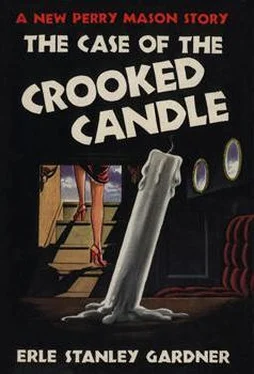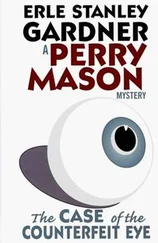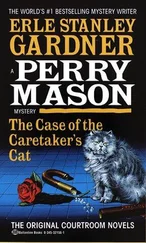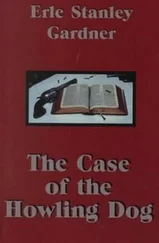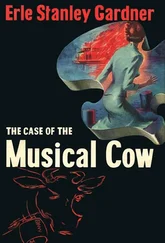“Quite right, Doctor. Now just tell us a little more about the cause of death, and the time of death.”
“In my opinion,” Dr. Newbern said, “unconsciousness was an immediate result of that blow. The victim never regained consciousness and, judging from the extent of the hemorrhage and the conditions I found in the brain, I would say that death occurred within five minutes.”
“In your opinion then, the victim never moved from the time that blow was struck?”
“That’s right.”
“Now when you first saw the body, Doctor, where was it with reference to the surroundings shown in this photograph which I now hand you?”
“The body was over here,” the doctor said, indicating a point on the photograph. “It was way over on the right hand side of the boat. That is, what is referred to in nautical terms as starboard side. It is the right side when you face the bow. This photograph was taken looking toward the stern of the boat. Therefore, the position where the body was found would have been in the left hand portion of this photograph.”
“I’ll show you a photograph, People’s Exhibit C, which actually shows a body and ask you if that is approximately the position and location of the body when you first saw it.”
“That is exactly the position and location of the body, yes, sir. That is the body as it was lying when I first saw it.”
“Did you make any examination of the premises when the body was discovered?”
“Not when the body was discovered,” the doctor corrected with a smile, “but when the police arrived.”
“You did make such an examination?”
“Yes.”
“What did you discover?”
Dr. Newbern said, “I discovered the body lying in approximately this position which, you will notice, is face up on the starboard side of the yacht. I noticed that under the head there was a pool of blood indicating a rather extensive hemorrhage. I also noticed that at another point in the cabin, the carpet was saturated with blood. Do you wish me to point that out?”
“Please.”
“That was in approximately here.”
Mason, getting up to walk around behind the witness so he could see the point the witness fixed on the photograph, said, “If the Court please, for the sake of the record, the doctor is now pointing to a portion of the photograph, People’s Exhibit C, which is in the upper right-hand corner and immediately in front of the door way which enters the after cabin of the yacht. That’s right, Doctor?”
“That’s right,” the doctor said.
“Thank you,” Mason announced and returned to his seat.
“You noticed there was a pool of blood here?” Linton continued.
“Yes, sir. And there were a few small bloodstains at more or less regular intervals between these two spots.”
“Did you make any examination of the threshold between the main cabin and the after cabin?”
“I did, yes, sir.”
“What did you find?”
“I found that the threshold was raised approximately three inches, as is, I believe, usual in yacht construction. I found that the threshold was covered with brass, and that there were spots of discoloration on this brass. I made scrapings of those discolorations and determined that they were human blood. I typed the blood and found that it was of the same type of blood as that of the body which was found in the position which I have indicated on the floor.”
“The point at which you have testified the body was found was a distance of several feet from that threshold?” Linton asked.
“Yes, sir.”
“Was there anything to indicate how that body might have been moved from the one spot, which we will refer to as position number one, to the other, which we will refer to as position number two?”
“Yes, sir.”
“What?”
“The force of gravitation could well have moved that body,” Dr. Newbern said smiling.
“Will you please explain?”
“When we boarded the yacht, it was almost low tide. The yacht had heeled way over until it was very difficult to keep one’s footing. The boat was tilted so that the starboard side was the low side, and so far as the medical evidence is concerned, it is quite apparent that as the tide had gone out the night before, the body had rolled over into approximately the position in which it was found.”
“The body could have done that without being touched by any person?”
“In my opinion the body would have done that without being touched if the period of low tide had preceded rigor mortis. If the body had been lying with the arms and legs outspread, and rigor mortis bad set in before the interval of low tide, it is quite possible the body would not have moved very much from its original position. But with a low tide intervening before rigor mortis set in, the body would very naturally have rolled over to the low part of the cabin.”
“When does rigor mortis set in?”
“As a rule, general stiffening will be well established within ten hours after death. Say ten to twelve hours to make a pretty fair average.”
“Rigor mortis had developed in the body at the time you saw it?”
“Oh yes.”
“And what time was that?”
“That was eleven-seventeen Saturday morning.”
“In your opinion, Doctor, what was the time of death?”
“The time of death,” Dr. Newbern said, “was from fourteen to eighteen hours before I first examined the body.”
“Can you fix that in terms of hours?”
“I examined the body at eleven-seventeen. I would, therefore, say that death occurred after five-seventeen the previous evening, and before nine seventeen. Any time within that four-hour limit would satisfy the conditions as I observed them.”
“The nature of the wound was such that it caused rather extensive hemorrhage?”
“Both external and internal, yes. There was a rather severe hemorrhage.”
“In your opinion, death was almost instantaneous?”
“I would say from the conditions which I observed that in this particular case unconsciousness followed immediately upon the blow, and death occurred within an interval of a few minutes.”
“Were there any other wounds on the body?”
“There was a contusion on the point of the jaw, just to the left of the point.”
“Indicating a blow?”
“Indicating a trauma of some sort. There was a well defined traumatic ecchymosis.”
“Any other wounds on the body?”
“None whatever.”
“Cross-examine,” Linton said. “He’s your witness.”
Mason slowly got to his feet, faced the doctor. “Then this wound, which we will describe as the fatal wound, is the only one which would have caused any hemorrhage?”
“That’s right.”
“Now then, Doctor, how long would hemorrhage from such a wound continue after death?”
“From this particular wound, I would say that any extensive hemorrhage would have ceased within a very few minutes after death.”
“What do you mean by a very few minutes?”
“Well, to be on the safe side, say ten or fifteen minutes.”
“On moving the body would there have been another drainage of blood?”
“Yes, sir. That’s right.”
“And how long would that have continued?”
“That would have continued for some time.”
“Then the pool which you found under the head of the body in the position in which you found it might have been the result of drainage from moving the body?”
“No, sir, I don’t think so. There were evidences of a true hemorrhage rather than mere drainage. And from the size, the nature and the extent of that stain on the carpet, I would say that it was the result of hemorrhage.”
“You aren’t, however, taking that into consideration in fixing the time of death?”
Читать дальше
